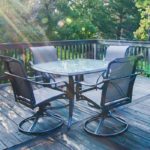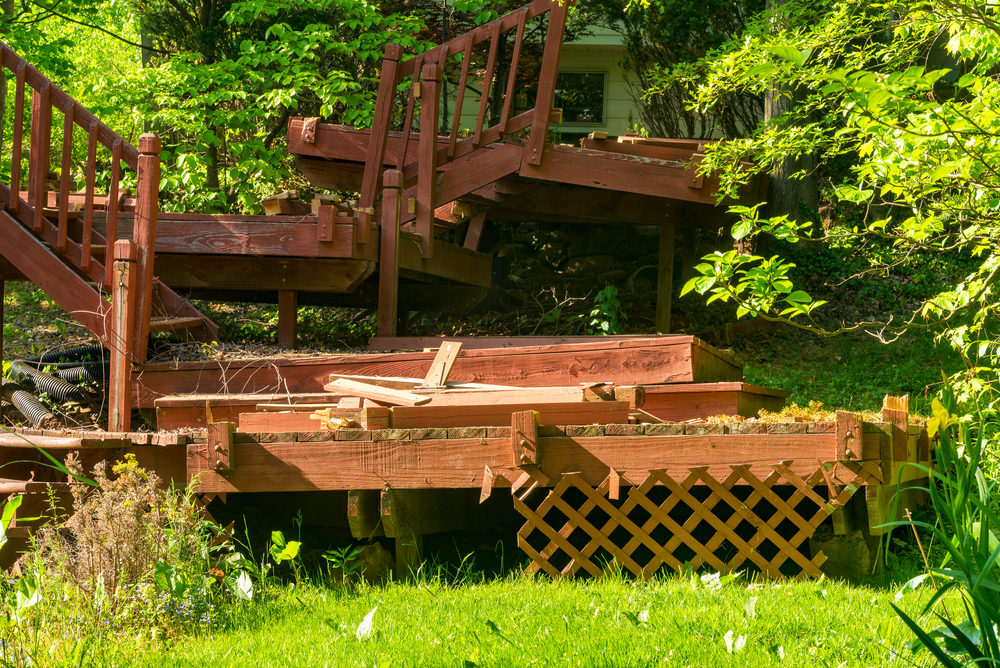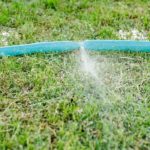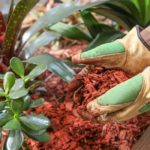Outdoor furniture tends to deteriorate much faster than the indoor kind. The reasons are pretty clear — outdoor furniture is constantly exposed to elements like sun, rain, and snow. So how can you make sure your outdoor furniture lasts?
Restoring outdoor furniture is a simple process, depending on the material you’re dealing with. Typically, you can start with a deep clean, then sand or buff the surface (with physical or chemical means), and, once the piece is dry, apply a sealant to prevent further damage from occurring.
Don’t wait until your outdoor furniture is in shambles. It’s time to utilize your DIY skills to restore your favorite pieces to their former glory. We’ll outline the full process for you — all you need is some elbow grease and a can-do attitude.
What Are the Most Common Types of Outdoor Furniture Damage?
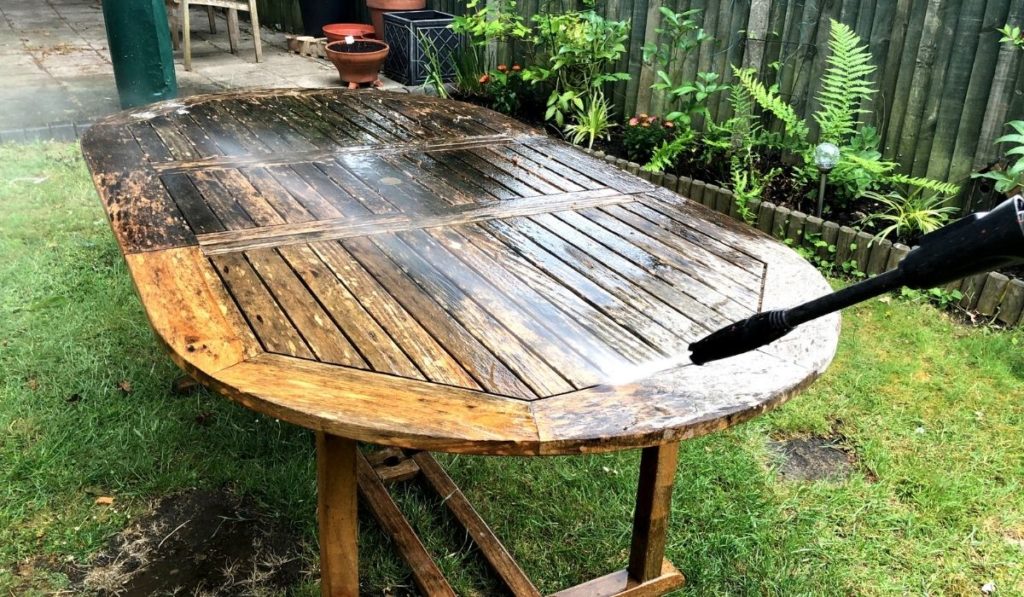
Before we get to the actual restoration process, let’s first take a look at what we’re dealing with. Of course, every environment results in different issues, but most damage to outdoor furniture comes from exposure to the sun, rain, and rot.
As a result, you should generally expect to deal with one or more of the following when it comes to restoring outdoor furniture:
Sun Damage
Whether you leave your set out by the pool or on a covered porch, there is no escaping exposure to UV rays. The sun’s rays can degrade any type of furniture; it fades the plastic, weaken the joints, and cause cracking or splitting of the synthetic wicker.
In addition, the sun rays break down the protective oils on wood, leaving a grey dried-out surface exposed to rot and decay.
Rain Damage
Once water finds its way into your furniture, it can wreak havoc very quickly. Water causes metal furniture to rust, and it can lead to mold in cushions or foam. If wooden furniture absorbs too much water, the fibers can swell and split, initiating an irreversible state of rot.
This usually happens when waterproofing coatings wear out over time.
Rust Damage
Metal furniture, especially anything made of iron, will rust if it’s not properly sealed. Even tiny spots of rust can quickly spread and turn a beautiful piece of furniture into a brittle mess.
Humid and salty air (such as near the beach) tends to speed up the formation of rust.
Rot Damage
The combination of moisture, wood, and warmth is your furniture’s worst nightmare. Rot happens when moisture gets trapped inside the wood and is then eaten away by fungus.
Rot can travel deep within the furniture before you notice any external damage. Rot can affect any type of wood, including cedar, cypress, redwood, and teak.
What You Need for Outdoor Furniture Restoration
Outdoor furniture is made of various materials, so you’ll need specific tools or products to handle the different issues. Here’s what you’ll need for a basic furniture restoration:
Cleaners: A gentle all-purpose cleaner should be enough for essential dirt removal. For more stubborn stains, you’ll need strong chemicals appropriate for the type of furniture you are dealing with.
- CLR Outdoor Furniture Cleaner (on Amazon) (All-purpose)
- Goo Gone Rust Remover (on Amazon) (Iron)
- Soda Crystals (on Amazon) (Plastic)
Protective Treatments: After clearing away the damage, you’ll need to restore the furniture’s waterproofing and apply finishing coatings to keep the elements at bay in the future. Here are a few examples of what you can use:
- Scotchgard Sun and Water Shield (on Amazon) (All-purpose)
- Howard SunShield Outdoor Furniture Wax (on Amazon) (Wood)
- Golden Care Teak Protector (on Amazon) (Teak)
- 303 Marine Aerospace Protectant (on Amazon) (Plastic, Ratten)
Tools: Here are a few examples of tools you might need:
- A bucket
- A scrub brush
- Sponges
- Disposable Rubber Gloves (on Amazon)
- 180 grit sandpaper (on Amazon)
- A sander
- A paintbrush
- Clean rags
How to Restore Outdoor Furniture
Bring your furniture to a well-lit area with good drainage. If you’re working near grass or plants, be sure to put down plastic sheets to avoid chemical damage.
Next, assemble the required tools and materials and prepare the furniture by clearing away any dirt with either a damp cloth or a garden hose. Don’t forget about your safety gear — check your rubber gloves for any holes before working with chemicals.
Restoring Wood Furniture
Wood is highly susceptible to moisture and heat damage, especially if it’s softwood. Hardwood, like teak, also turns grey due to sun exposure over a long time. Wood is restored by sanding away the top layer and then treating it with a wood protector.
- Using medium-grit sandpaper, lightly sand the surface in the direction of the grain. You only have to strip away the dirty top layer, so don’t be too aggressive with it.
- Remove the dust with a soft brush or blower. Finish the process by wiping it down with a clean rag soaked in mineral spirits or an all-purpose cleaner.
- Once the wood is dry, apply a few coats of a wood-sealer like Howard SunShield Outdoor Furniture Wax (on Amazon). Teak Protector (on Amazon) can be used for restoring teak furniture. Work the oil into the wood with a clean rag and allow it to soak; it’ll give a really nice shine to the wood and protect it for years.
Restoring Wrought Iron Furniture
Iron furniture becomes susceptible to rust when the paint or varnish coating wears out. Restoration will therefore focus on removing the rust and protecting it from future exposure.
- Rinse off the dirt with a garden hose. If the furniture is especially filthy, mix up some dishwashing detergent and water in a bucket and use a scrub brush to remove the dirt.
- Apply Goo Gone Rust Remover (on Amazon) to any rusted areas. Pay special attention to hinges or joints that are particularly prone to rust. Let the product sit for a while, taking into consideration the manufacturer’s instructions, then use a wire brush or steel wool to scrub off the rust.
- Finish the job by applying paint or varnish to the surface. Grease the joints where necessary using a light oil like WD-40 to prevent rust.
Restoring Plastic Furniture
Plastic furniture can be damaged by UV rays and discoloration is common. The restoration process is essentially about reviving the faded plastic.
- Give the furniture a good rinse, clearing away loose dirt and surface stains.
- Mix up a solution of soda crystals (on Amazon) and water in a bucket, dampen a sponge with the solution, and lather it onto the furniture.
- Let it sit for a few hours, then wash the furniture with a hose. You can repeat if necessary.
- Once the furniture is dry, apply a thin layer of car wax or 303 Marine Aerospace Protectant (on Amazon) for a nice sheen.
Restoring Rattan Furniture
Rattan furniture is made of woven, dried-out rattan vines. It’s fairly resistant to water damage but isn’t immune to weathering or fading.
- Use a damp cloth to wipe away dirt and dust.
- Mix up a solution of detergent and warm water in a bucket and lather it onto the furniture using a rag or sponge.
- Wipe down the solution with a clean, damp cloth, making sure no residue is left over. Then let it dry in the sun.
- If your rattan furniture is too old and worn, you can restore the shine by applying some olive oil with a rag.
How to Prevent Outdoor Furniture Damage
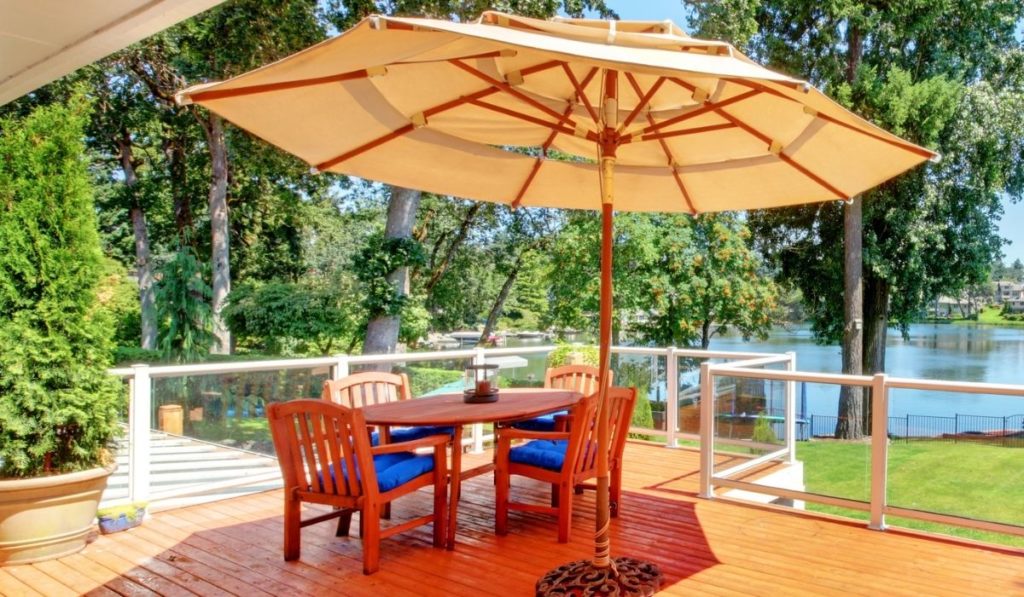
Outdoor furniture is a lovely investment, but it’s also very vulnerable to the elements. To avoid spending too much on restoration costs, here are some tips to prevent damage in the first place.
1- Clean Regularly: Dust, dirt, and other particles accelerate deterioration. Make a habit of cleaning your outdoor furniture every few weeks and doing a deep cleaning at the end of every season.
2- Protect Furniture from the Sun: Direct sunlight weathers wood, plastic, and rattan furniture. Keep this furniture under covered patios or umbrellas, or at least use opaque outdoor covers under full sun.
3- Move Furniture During the Winter: Wood and plastic furniture can’t stand the harshness of winter, so it’s best to store it in a dry place during the winter. Metal furniture can handle cold temperatures but check for any signs of rust before the winter season begins.
4- Protect Furniture from Rain: Though outdoor furniture is usually somewhat resistant to water, it will suffer if it’s constantly exposed to rain. Try to find some shelter for your furniture during storms. Consider purchasing outdoor furniture covers if you have no other option.
5- Prevent Erosion: Outdoor furniture is very vulnerable to erosion. Make sure you apply a sealant like polyurethane to wooden furniture. For metal furniture, apply good paint. The best way to protect rattan or plastic furniture is by keeping it in the shade.
Keep a close eye on your outdoor furniture. Look for signs of water damage, cracks, holes, rust, and molding, and repair any damage before it gets worse. The more you keep up with maintenance, the less you’ll be spending on restorations later on.


